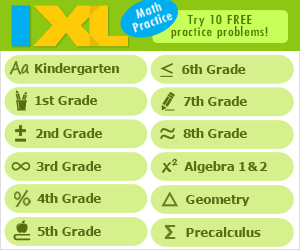7th Grade English Language Arts - Logic Standards
Links verified on 6/2/2014
To work on seventh grade logic standards, click on the numbers below to visit pages of internet resources for each of the learning standards.
Checks for Understanding are at the top of this page. Scroll down to find internet resources related to the State Performance Indicators (SPIs).
Checks for Understanding (Formative/Summative Assessment)
0701.5.1 Predict Events - Make logical predictions of future events in text. 0701.5.2 Sequence Events - Identify sequence of events in text. 0701.5.3 Complete Analogy - Construct and complete analogies using synonyms, antonyms, homonyms, categories, subcategories, whole/part, functions, and verb forms). 0701.5.4 Cause-Effect - Identify and analyze stated or implied cause-effect relationships in text. 0701.5.5 Fact/Opinion - Determine simple criteria for recognizing factual claim and opinion (e.g., scientific method, provability, quality of evidence, sources). 0701.5.6 Support Argument - Determine the relevance and quality of evidence given to support or oppose an argument. 0701.5.7 Compare and Contrast - Compare and contrast evidence and conclusions between two or more arguments on the same topic. 0701.5.8 Deductive and Inductive Reasoning - Identify and analyze examples of deductive and inductive reasoning in text. 0701.5.9 Premise and Fallacy - Understand the meaning of the words premise and fallacy. 0701.5.10 Argument Structure - Identify and describe the structure of an argument, including its main claim and supporting premises. 0701.5.11 Identify False Premise - Identify a variety of false premises, including those involving categorical claims (e.g., all mammals are human beings). 0701.5.12 Persuasive Devices - Identify the persuasive devices in written and oral communication (e.g., bandwagon, loaded terms, testimonial, name-calling, plain folks). 0701.5.13 Logical Fallacies - Explore common logical fallacies (e.g., appeal to fear, personal attack, false dilemma, false analogy) a variety of texts. 0701.5.14 Stereotyping and Bias - Explore the concepts of stereotyping and bias. State Performance Indicators
SPI 0701.5.1 Predict Outcome - Make predictions about the outcome of a given text. SPI 0701.5.2 Fact or Opinion - Evaluate text for fact and opinion. SPI 0701.5.3 Cause and Effect - Identify stated or implied cause-effect relationships. SPI 0701.5.4 Persuasive Devices - Identify examples of persuasive devices (i.e., bandwagon, loaded terms, testimonial, name-calling, plain folks). SPI 0701.5.5 Analogy - Select the correct word or phrase to complete an analogy, using synonyms, antonyms, homonyms, categories, subcategories, whole/part, functions, verb forms). SPI 0701.5.6 Deductive or Inductive - Identify an example of deductive or inductive reasoning in text. SPI 0701.5.7 False Premise - Identify a false premise in text. SPI 0701.5.8 Inferences - Make inferences and draw conclusions based on evidence in text. Review Help Resources to help review Seventh Grade English Language Arts standards
Search Internet4Classrooms

Custom Search






